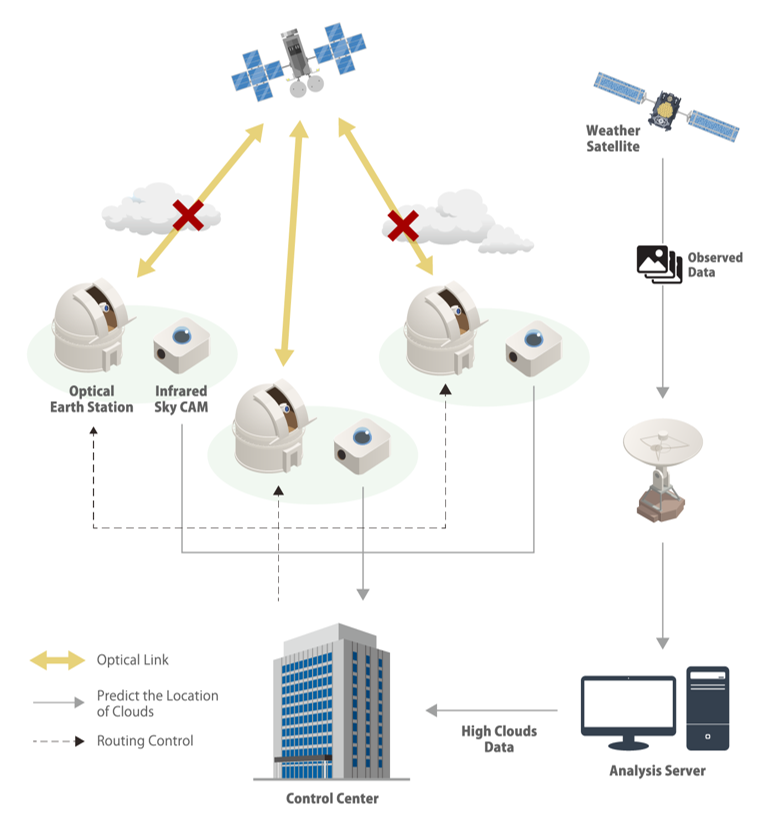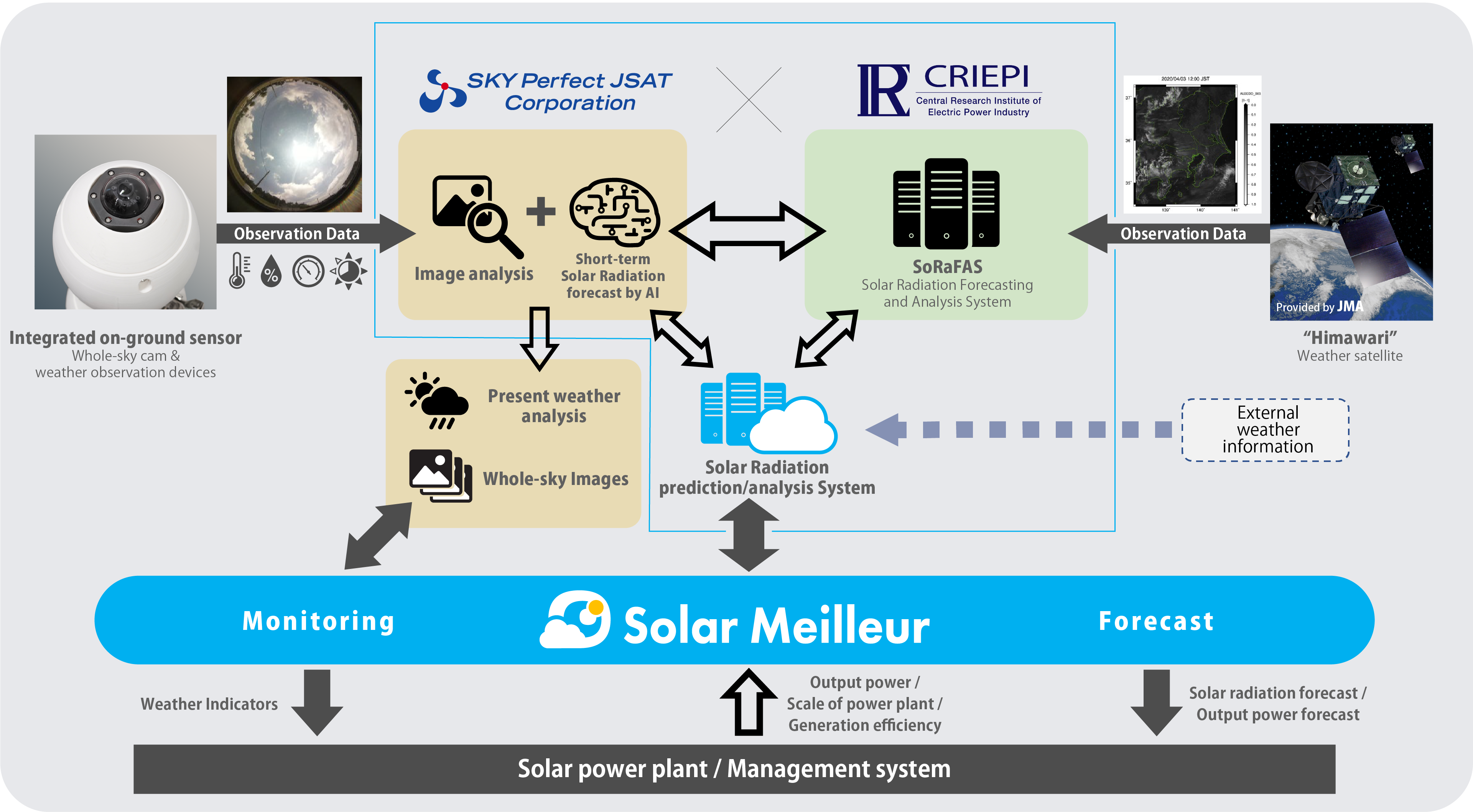Solar Meilleur
Solar radiate prediction and specified weather monitoring
Environmentally friendly
Solar Meilleur:
Solar Meilleur visualizes the Present
and Future of Solar Power Plant.
Integrating IoT, AI, and weather satellite imagery, the system provides "current status monitoring of power plants" and "forecast of solar radiation/power output from 5 minutes to 3 days later," which is a challenge for expanding the use of solar power generation.
-
POINT 01
Future Prediction
- “Solar TAMAGO“, an IoT device installed at solar power plants, captures whole-sky images and then our proprietary AI analyses these images to predict the amount of solar radiation 5 to 30 minutes later.
- Combined with solar radiation forecasts based on meteorological satellite images, the system provides "solar radiation and solar power output forecasts from 5 minutes to 3 days later".
-
POINT 02
Present Monitoring
- "The Solar Meilleur system provides real-time whole-sky images of the sky above the solar power plant, captured by our proprietary IoT device “Solar TAMAGO”.
- The system, powered by our unique AI analytics, outputs proprietary weather indicators that represent the current amount of output power.
- By combining this with the status of the power plant, efficient operation and maintenance can be realized.
-
POINT 03
Solar TAMAGO
- "Solar TAMAGO" is an IoT device equipped with a whole-sky camera, LTE communication, and weather sensors such as temperature, humidity, and barometer.
- It collects real-time information on weather conditions at pinpoint locations where solar power plants are installed.
- These images cannot be captured by weather satellites, and they can be used to analyze the state of sunlight blockage by clouds, which is a direct cause of output power attenuation.
What is Solar Meilleur?
The science is clear: to avoid the worst impacts of climate change, emissions need to be reduced by almost half by 2030 and reach net-zero by 2050.
To achieve this, we need to end our reliance on fossil fuels and invest in alternative sources of energy that are clean, accessible, affordable, sustainable, and reliable.
Renewable energy sources – which are available in abundance all around us, provided by the sun, wind, water, waste, and heat from the Earth – are replenished by nature and emit little to no greenhouse gases or pollutants into the air.
However, solar power generation is highly variable due to changes in weather and cloud cover, so highly accurate prediction of power generation based on solar radiation is essential to fully utilize solar power and ensure a stable supply of electricity.
Since 2017, we have been developing KMOMY, an AI that analyzes clouds. Applying this technology, we have developed a solar radiation forecasting system using whole-sky images from the IoT device "Solar TAMAGO."
The Central Research Institute of Electric Power Industry has developed "SoRaFAS," a solar radiation forecasting and analysis system that uses image data from the Himawari weather satellite to make forecasts one hour in advance.
The two parties are jointly developing a hybrid solar radiation forecast that utilizes the strengths of their respective technologies.
The whole-sky images, temperature, humidity, air pressure and other data collected by "Solar TAMAGO" at the location where the solar power plant is installed, can detect changes in weather conditions that are the direct cause of changes in the current power generation.
Applying Solar Meilleur technology to optical space communications
The need to observe the Earth from space and the expansion of Internet access via low-Earth orbit satellites have increased the amount of communications data flowing through space, and optical communications is attracting attention for space-to-ground data transmission where higher speed and greater capacity are required.
Optical communication between space and ground has the problem that the line is interrupted by clouds in the communication path, and network routing that avoids clouds by distributing optical ground stations is being considered.
JAXA: Japan Aerospace Exploration Agency, Tokai University and SKY Perfect JSAT. jointly conducted a study to improve the time resolution of cloud avoidance operations required for space-to-ground optical communications, using the cloud movement prediction technology developed by Solar Meilleur.
-

Cloud avoidance operation in space-to-ground optical communications
Refer to "Study on Improvement of Time Resolution of Cloud Avoidance Operation for Space-to-Ground Optical Communication (Japan Aerospace Exploration Agency, Tokai University, and SKY Perfect JSAT Corporation)
Thank you for your interest in SKY Perfect JSAT.
To contact us, please click here.
- LIANA
- TELEPORT / Ground Facilities
- LEO Teleport / Housing Service
- Maritime(JSATMarine)
- Aviation
- Managed service covering APAC region
- IoT Connectivity Solution
- Cellular Backhaul
- Japan Domestic Services
- CONTENT DISTRIBUTION & CREATION
- Solar Meilleur
- Activities for the Future
- Satellite Operation Service

